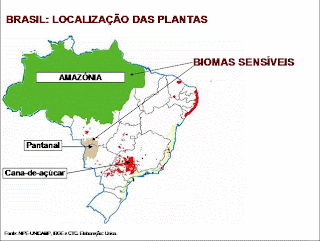Anyone who has been following closely the recent arguments about the ethanol boom and the expansion of sugarcane plantations in
Pointing to the “sensitive biomes” of the Amazon and the Pantanal (the largest inland wetland on Earth), the map shows that the concentration of sugarcane production and ethanol plants is a safe distance from both. It is a compelling visual demonstration, until you ask the question: what is all that white space in the middle of the map?
The answer, it turns out, is the Cerrado, or Brazilian woodland-savanna. One of the world’s 34 biodiversity hotspots as defined by Conservation International (CI), it is home to 4,400 plant species that occur nowhere else in the world, 10 threatened endemic bird species, and a range of charismatic mammals including giant anteater, giant armadillo, jaguar and maned wolf. It has also, according to CI, lost nearly 80 per cent of its original vegetation, which is why it qualifies as a hotspot (the Amazon, which has only lost some 16%, does not).
Looked at this way, the map seems somewhat less than reassuring as a guarantee of the environmental sustainability of sugarcane and its current focus of expansion in
The WWF report, sponsored by the Government of the
As the study developed, however, the sugar issue was overshadowed by the extraordinary boom in ethanol production, with the Brazilian sugar-alcohol industry attracting massive international interest – both positive and negative – for its unrivalled technological experience and capacity to increase production in the era of astronomical oil prices and concern about fossil fuel impacts on global warming.
In its conclusions, presented at one of a series of debates on biofuels at the University of São Paulo, the WWF report shows a curious contrast between the “headline” judgements – overwhelmingly positive – and some of the detailed analysis, which points to the need for significant strengthening of existing safeguards to prevent environmental harm and threats to food security in particular regions.
On the big picture, the co-ordinator of WWF-Brasil’s agriculture and environment policy, and principal author of the report, Luiz Fernando Laranja da Fonseca, presented an analysis which differed little from that regularly set out by the Brazilian government and by the sugar-alcohol industry itself.
Essentially, the analysis attempts to shoot down two principal “myths” about biofuels expansion in
The WWF report argues that at this “macro” level, the negative impacts of sugarcane expansion are low, and that there are significant benefits to the climate from using one of the world’s most energy-efficient forms of biofuels production – made even more efficient by the growing use of the woody crop waste known as bagasse to generate electricity.
When it comes to potential regional impacts, however, the report paints a very different picture, especially regarding the Cerrado. It cites another report published late last year by the Institute for Society, Population and Nature (ISPN), funded by the EU. This report suggested that some of the areas currently experiencing the most rapid growth in the planting of sugarcane were also those identified by Brazil’s federal environment ministry (MMA) as priority areas for conservation of the Cerrado ecosystem.
Source: ISPN, from MMA and INPE
For example, in this map showing part of the state of Goiás to the west of the federal capital
Even in the areas of
On the question of food security, the report also cautions that at the local level, there is a risk that small-scale agriculture, which produces the great majority of
The WWF study also acknowledges that while the direct impact on the Amazon from sugarcane production is minimal – although a small amount is grown in the region – there is a risk of indirect impacts if the displacement of cattle production and other crops in the Centre-South region by sugarcane pushes those activities to the rainforest frontier. However, it does not come to a firm conclusion on this, arguing instead that methodologies should be developed to measure these indirect impacts.
So lurking beneath the generally positive outlook on ethanol expansion given in this WWF analysis lie some pretty severe points of caution. Perhaps one of the key messages is that if the industry and its supporters really want to put a convincing case for the sustainability of this booming biofuel, the Cerrado should cease to be an invisible white gap on the map, and acknowledged as a valuable ecosystem worthy of care and attention in the planning of energy and food production in Brazil.
This article was published on www.oeco.com.br


2 comments:
Hi Tim,
Now that I have discovered your blog I will be a regular reader. I, too, have a great interest in Brazil. You will be surprised to learn more about me. Meanwhile, I was wondering why you are doing your blog. Do you want a lot of readers, or is it more a place to store articles which, by the way, are terrific and very professional? Talk to you later. Keep up the good work!
Alex Zeferino, Jr.
Sorry Alex I only just saw this comment as I forgot to put the settings to email me notifications. In answer to your question, it is intended mainly as a convenient way of compiling my published work rather than attracting a big audience -- though if people find them interesting in their own right, that's fine! Thanks for your comment.
Post a Comment